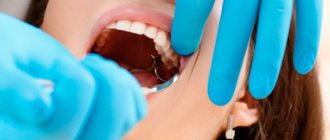Dentists try to preserve their patients’ natural teeth, but this is not always possible. In some cases, the only correct solution is to remove the tooth. This is a simple operation that is performed under local anesthesia. It should be carried out by an experienced specialist. To minimize the risk of complications, you must follow your doctor's recommendations.
- Do not touch the area of the extracted tooth with your tongue, do not rinse your mouth or drink through a straw. All this can lead to the washing out of the blood clot located in the hole. Without it, food particles and bacteria can enter the wound.
- In the first week after surgery, do not take a hot bath or visit the bathhouse or sauna. Try to minimize physical activity and get plenty of rest.
- Use a soft-bristled brush to clean your teeth to avoid damaging soft tissue.
- Apply a cold compress to your cheek to relieve swelling and reduce the risk of a hematoma.
- If necessary, take pain medications recommended by your doctor.
If you neglect the listed recommendations, the rehabilitation period will increase, and complications may develop.
Norm and pathology
The tooth extraction procedure involves violating the integrity of the soft tissues and mucous membranes, muscles and ligaments that surround the diseased tooth and are responsible for reliably holding the root in the gum. That is why it is quite logical that after the operation a slight inflammation may begin, characteristic of the wound healing period.
Its main symptoms are: moderate pain when speaking and opening the mouth, discomfort when trying to chew even soft food, discomfort at rest and during movement. Bleeding may also occur, which usually stops several hours after the tooth extraction procedure.
At the site of the gum incision, sharp pain may appear, which radiates to the head and can cause the onset of a migraine. Also considered normal is slight swelling, redness or slight bluish discoloration of the soft tissue. Sometimes a person experiences an increase in body temperature, and the injured area may “burn.” These symptoms usually go away on their own a few days after the intervention.
How long does it take for gums to heal after tooth extraction - timing
How long it takes for the gums to heal after tooth extraction depends on many factors: the degree of trauma of the removal, whether sutures were applied, the possible addition of infectious inflammation of the socket, and the age of the patient. Healing of the hole after tooth extraction can be divided into partial and complete.
Partial epithelization of the wound occurs on average in 12 days (Fig. 5), but complete epithelization of the surface of the clot is observed in 20 to 25 days (Fig. 6). However, if inflammation of the socket occurs or after a complex tooth extraction, which is usually accompanied by major bone trauma, the healing time may increase by several days.
Reasons for slow healing –
- significant trauma to the bone and gums during removal (both due to the doctor’s indifference and as a result of sawing out the bone around the tooth with a drill during difficult removal),
- when a clot falls out of the socket (empty socket),
- development of alveolitis of the socket,
- the doctor left fragments or inactive fragments of bone tissue in the socket,
- if sharp bone fragments protrude through the mucous membrane,
- if the gum mucosa around the hole is very mobile, and the doctor did not apply stitches,
- antibiotics were not prescribed after a complex removal,
- patient's age.
Possible complications
If serious inflammatory processes arise in the gum, then after surgery it may change its color to bright red, blue or black. If all this is accompanied by pain, the gums become loose to the touch, and purulent discharge appears, then you should immediately contact the clinic for an examination.
The most common complications include the appearance of cysts. They are small formations containing a small amount of clear liquid inside. If you seek help in a timely manner, treatment may be limited to drug therapy.
Other common pathological processes that occur against the background of gum inflammation include alveolitis, periostitis and gumboil. Flux appears due to infection in the periosteum tissue. Alveolitis manifests itself in the form of redness and significant swelling in the wound area. The patient may complain of acute pain, the appearance of pus, fever and poor health. Also, the pathology is often accompanied by bleeding, which cannot be treated with improvised means.
How to speed up wound healing after tooth extraction -
The best remedy that can speed up the healing of the gums after tooth extraction is the placement of sutures on the socket of the extracted tooth by a surgeon immediately after the tooth is extracted. Moreover, it is necessary that the edges of the gum mucosa be as close to each other as possible. This will speed up healing and reduce the risk of inflammation in the socket of the extracted tooth. But if you have already had a tooth removed without stitches, then topical oral products may help (see below).
Additional topical products - patients often ask if there is an ointment for healing wounds after tooth extraction... If you are not satisfied with how long it takes for the gums to heal after tooth extraction, then this process can really be accelerated. Rapid healing of wounds in the oral cavity is possible with the use of agents that accelerate the epithelization of wounds on the mucous membrane. These means include -
- Solcoseryl in gel form,
- Solcoseryl in the form of dental paste,
- Actovegin in the form of 20% gel.
It should be noted that these drugs also have a good analgesic effect. You can read about the specifics of their use after tooth extraction using the links above, but if you are a fan of “grandmother’s” remedies, then regular sea buckthorn oil may also come in handy (although its effect will be noticeably more modest).
Blackening of the gums
A change in gum color does not always indicate the onset of inflammatory processes. If the gums at the site of the incision become whitish, this is considered one of the normal variants. This is how fibrin manifests itself, which tightens the wound and protects it from bacteria getting inside.
However, if the bed and adjacent fabrics have turned dark blue or black, this is a cause for concern. Blueness indicates the transition of inflammation to the third stage, which can lead to complete atrophy of the gum tissue.
The gums begin to turn black already when the irreversible process of decay has begun. This is usually accompanied by purulent discharge, a strong and very unpleasant odor from the mouth, and severe pain that cannot be controlled with conventional painkillers.
Symptoms
In addition to visual changes in soft tissue, the following symptoms may occur:
- pain when eating and brushing teeth;
- itching;
- swelling of the mucous membrane;
- the appearance of bleeding;
- abundant plaque on the teeth and the appearance of mineralized deposits.
Symptoms depend on the cause of the pathology and on the individual characteristics of the patient’s body. Eliminating cyanosis of soft tissues is the first step in treatment and in making the patient feel better.
When to seek help from a specialist
- The blue color of the gums does not subside for more than four to five days;
- Blue discoloration is accompanied by swelling and bleeding;
- Acute pain appears that is not relieved by painkillers;
- Body temperature can rise to 38 - 39 degrees;
- Loss of strength, general weakness.
Ignoring the disease is fraught with the development of serious complications, including the formation of an intraoral cyst.
What can you do
The first thing to remember: when the very first symptoms of an incipient inflammatory process in the oral cavity appear, it is important to contact a medical facility as quickly as possible. It is almost impossible to independently identify the cause and stage of development of the pathology, and treatment with folk remedies can lead to more serious consequences.
Inflammation at the initial stage is easily eliminated by rinsing. For this purpose, certain medicinal herbs may be prescribed, for example, thyme, sage or oak bark. They are ideal for regular rinsing, reduce pain and swelling, and have a powerful antibacterial effect.
The doctor may also prescribe analgesics, for example, Dolaren or Ketanov. Unfortunately, when the inflammatory process enters an advanced stage, such therapy will not bring the desired result. In this case, the dentist may prescribe washing the infected hole and treating it with medicinal applications. General recommendations include preventive rinsing of the mouth with antiseptics at home, for example, Chlorhexidine solution. It is also best to temporarily stop taking blood thinning medications, smoking, and drinking any alcoholic beverages.
previous post
How to make teeth whiter?
next entry
- What to do if there is bleeding
- How to relieve pain after surgery
- What to rinse your mouth with and when
- When can you eat after tooth extraction?
- Is it possible to refrigerate
- Is it possible to heat
- Is it possible to smoke and drink alcohol?
- Is it possible to play sports
- How to brush your teeth
- What to do if your gums are inflamed
After the operation, the dentist will place a tampon in place of the extracted tooth to stop capillary bleeding. Squeeze your jaws tightly and do not remove the tampon for 20 minutes. This is necessary so that a clot of coagulated blood forms in the hole. It will protect the hole from the penetration of bacteria, food particles and inflammation. Avoid rinsing or spitting to preserve the clot.
If the bleeding doesn't stop, you may have poor clotting ability or high blood pressure. In this case, it is better to hold the tampon for 40-60 minutes.
Do not try to clean or rinse the socket; try not to touch it with your tongue. This will lead to infection in the wound. If you notice that something is wrong with the wound, consult a doctor.
The anesthesia will last from a few minutes to several hours. At this time, the pain will begin to increase - it can be relieved with any suitable painkillers or medications prescribed by the doctor.
If pain persists in subsequent days, you should consult a doctor.
You cannot rinse for 24 hours after surgery. To make the wound heal faster, rinsing with a decoction of chamomile, calendula, and oak bark will be useful. Before rinsing with chlorhexidine, furatsilin, miramistin and soda-saline solutions, take warm water into your mouth, hold it and carefully spit. Then put the solution in your mouth, hold it for 15-20 seconds and carefully spit. Repeat rinsing with the solution several times.
Do not eat or drink for 2-3 hours after surgery, wait until the anesthesia wears off and the blood clot hardens. If you start eating before the pain relief has worn off, you could seriously injure yourself, such as biting your tongue or cheek.
It is better to chew food on the side where the operation was not performed, or to avoid contact with the removal area. Try not to eat rough, hot or spicy foods. For example, nuts can clog the site of an extracted tooth and inflame the gums. Spicy or hot foods will increase blood flow - swelling will appear, the clot will dissolve and healing will take longer.
A cold compress constricts blood vessels, reduces the risk of swelling, reduces bleeding and the possibility of inflammation. Apply the compress through a thin cloth and do not hold it for longer than 25 minutes. If your dentist does not advise you to use cold compresses, you do not need to do them - consult your doctor.
Do not visit the bathhouse, sauna, solarium, take a hot bath or sunbathe on the beach for 3 days after surgery. Take a shower and wash your hair with warm water. If you overheat, blood flow will increase and bleeding or inflammation may begin.
Smoking and drinking alcohol provokes bleeding, irritates and infects the mucous membrane. Try not to smoke the day before and 1-2 days after surgery so that the wound heals faster.
Alcohol will dissolve the clot, which protects the wound from infection - do not drink for three days after tooth extraction. If you are taking antibiotics prescribed by your doctor, you should avoid alcoholic beverages for 2 weeks.
Physical activity increases blood pressure and blood flow - avoid exercise for the day after surgery. If your gums were sutured during tooth extraction, the sutures will come apart due to stress. Try to control your facial expressions, do not open your mouth wide.
Brushing your teeth after surgery is mandatory. Do this as usual, but make sure that the brush does not touch the socket and thoroughly clean the adjacent teeth. Use less toothpaste and rinse your mouth carefully.
If you damage the clot, there is a high probability of inflammation. Signs:











